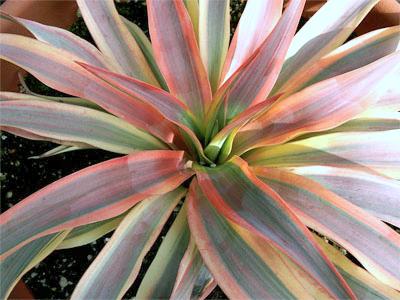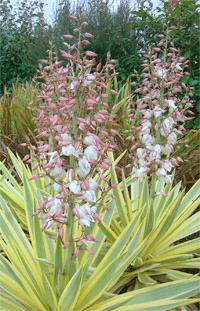Plant of the Month: Yucca
Bright Star
Yucca gloriosa ‘Walbristar’ (Bright Star yucca)
AT A GLANCE
Latin name: Yucca gloriosa ‘Walbristar’ (‘Bright Star’)
Common name: Bright Star yucca
Flowers: Large clusters of white pendulant blossoms
Mature size: 3’ tall by 3’ wide
Hardiness: Zones 7-10
Soil: Well-drained
Exposure: Full sun
Water usage: Low
Sources: Local nurseries
As I look out at my winter containers, most appear truly sad from the cold — and from me forgetting to water them. But one really stands out — a large terracotta pot filled with Yucca ‘Bright Star’. This evergreen lily relative really shines in the winter landscape with its golden variegated foliage, which is burnished with bronze and red from the winter cold. During summer, the foliage is apple green with bright sunny yellow margins. The plant is crowned in mid-summer with huge 5-foot spikes of pink buds opening to large white flowers. Hummingbirds jealously guard the plants when they are in flower.
This yucca is quite slow growing, but will eventually reach 3 feet tall and wide. If you find one at your local nursery, most likely it will be in a 5-inch to 1-gallon container. I recommend you do what I did, and put it in a terracotta pot and enjoy it as a container plant until it gets too big. Each year simply move it to a larger pot as it grows. Make sure to place it in full sun for best foliage variegation, and take care that the soil is well drained. I hate to admit it, but this plant shines in my garden because in my busy life my container plants often have to wait awhile before I get around to watering them. ‘Bright Star’, like all yuccas, can survive with very low amounts of water, though it and other yuccas will grow faster if given regular feedings and irrigation.
Yes, I know that the plant has a tiny sharp point on the end of each leaf. But unlike the points on agaves and hollies, these really aren’t that bad. You can safely move the plants and walk around them without getting punctured. Luckily, the plants are enough of a menace that deer and rabbits will leave them alone.


